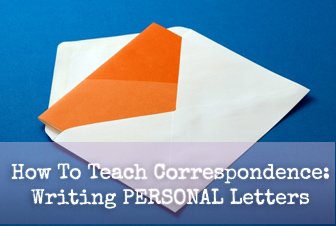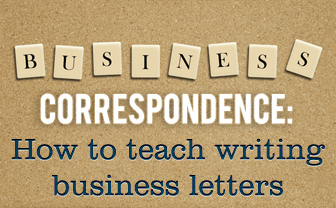How to Teach Correspondence to Your ESL Students: Writing Personal Letters


The following is part two of the step-by-step process of teaching these types of correspondence to your ESL students (see Part One: “Writing Personal Letters” here).
The Business Letter
Now that your students have written a personal letter, it is time to move on to the more formal business letter. You will want to remind your students of the reasons to write a business letter that they generated in the first brainstorming activity. You can use one of their ideas if you like, but having your students write to a local business that they frequent is a way to support your community and help your students express themselves at the same time. If you do not want your students to write to a local business, you may want them to write to a larger company that makes a product that they like. The advantage to doing this is that your students may receive correspondence in return with coupons or some other useful item included. If you decide to do this, you can create a bar graph to track the number of students who received return correspondence though they should not expect to receive a letter in return. You could also make a place in your classroom to post any return correspondences students have received for the rest of the class to read.
Because business letters are more formal, encourage your students to type the final drafts of their letters. If you have the resources available in class, you can have students type during their writing workshops. If you have a computer lab at the school, your class can type their letters from the beginning. If neither of these are a possibility, have your students write their letters in class and then type them for homework. The structure of a business letter will be different from that of personal letter, and you will want to make the differences clear to your students. They will still begin with a return address and date, but this time they will be justified on the left side of the page. After the date, students should skip a line and then include the name of the person to whom they are writing, Mr. or Ms. and then first and last name. Below that, students should include the recipient’s address. All of these pieces will be in line on the left side of the page. Students should then write the greeting, again left justified. This time they will address their letter with Mr. or Ms. followed by the person’s last name and a colon. This colon is different from the comma used in a personal letter. Another difference between personal and business letters is the paragraph structure. In a personal letter, your students follow the convention of indenting each paragraph. With a business letter, instead of indenting each paragraph, they will be left justified, but your students will skip lines between the paragraphs to separate each one. Again, give your students class time to write the message and then move on to the closing. The closing will be left justified like the rest of the letter, but you will want to take some time with your class to brainstorm closings appropriate for a business letter. The most common closing will be sincerely, but your students can also use best regards or any other closings you think are appropriate. Finish the business letter with a closing, usually sincerely. When typing the letter, tell students to skip three lines and then type their names, first and last. After the letter is printed, your students should sign their name by hand.
Now that your students are finished with the letter itself, it is once again time to address the envelope. This time you should give them a larger, business envelope. The full sheet of paper on which they typed their letters should be folded into thirds and then will fit perfectly into the business envelope. Most business letters will have a printed envelope, but this may be beyond what you want to do with your class, especially with younger students. You can have your students address the envelope the same way they did for the personal letter, affix the stamp and mail. Your students have now completed their business letter and can hope but should not expect a reply.
Step Out Further
If you are in a setting where you can take field trips, round out your letter-teaching unit with a visit to your local post office. This is a great listening activity if the postmaster or mail carrier gives your students a tour and explains how mail is processed. It is also an interesting lesson in culture for students from other countries. Though you can mail a letter anywhere in the world, the way the mail is processed may be different from country to country, and your students will find it interesting to see the differences.
You can also use a classroom post office to encourage your students to keep writing to one another. For more information on this, see Mail Call! Turning Your Classroom into a Life-Size Post Office available in ‘ESL Essentials’ section.
The Memo
A final type of correspondence to teach your students is the memo. The memo is still for business purposes but is shorter and follows different conventions than the business letter. A memo is used between employees in one company and not for colleagues outside the company. Like the business letter, the entirety of the memo will be left justified and paragraphs will not be indented. A standard memo will have preprinted labels or places for the writer to insert his information. It will look something like the following.
Memo
To:
From:
Date:
Re:
A colon should follow each of the preprinted labels, and the message of the memo will go below the preprinted section. If you decide to have your students write memos, you may want to print a memo template for them and just have them fill in the necessary information. There are many memo templates available with word processing programs and on-line. When your students write memos, they should write them to another person in the class. You will need to explain that re: means regarding and that this is where they should state the purpose or topic of the memo in a word or two. A memo does not need an envelope, but your students should give the memos to you and you should distribute them to the recipients.
Give your students the tools they will need to be successful outside the world of e-mail and text messaging by teaching a unit on letter writing. The information is sure to be useful to your students no matter what their futures hold.